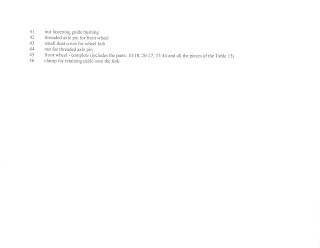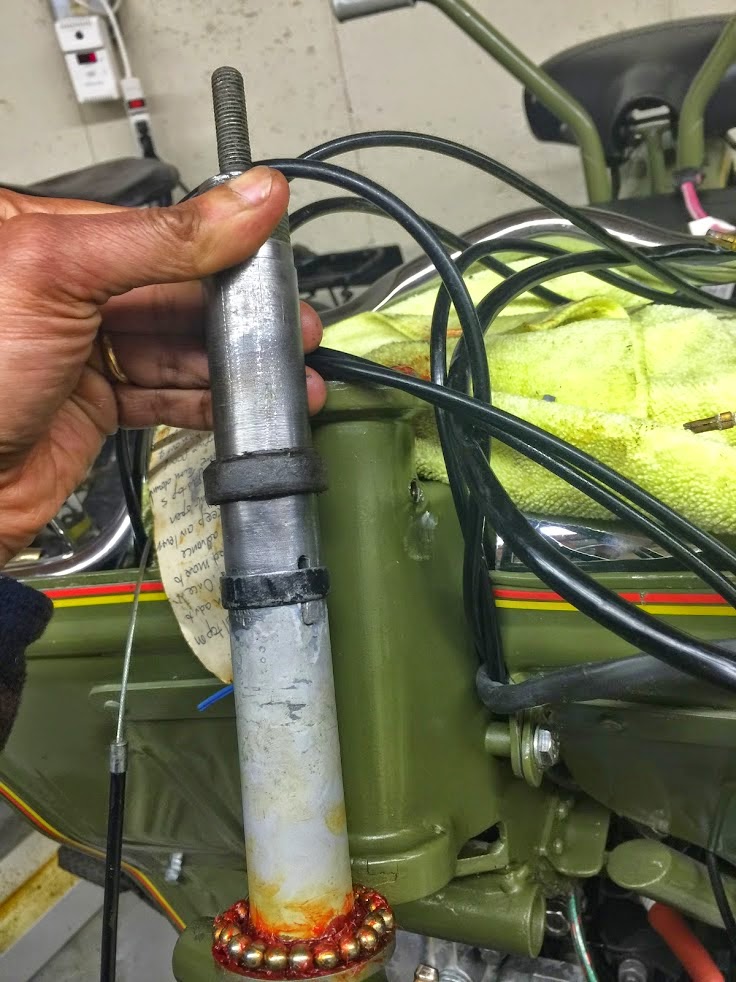 diagram that nothing is original. The spokes are removed using Fasst Company's spoke wrench. I cleaned the rims using my sandblaster prior to painting. The spokes were blasted too and blacked with Eastwood's metal blackening solution. I used Motorcycle Consumer News' technical library as my guide. This was the clearest and most detailed of the various wheel building articles out there. I used a Handy wheel balancing stand to true the wheel.
diagram that nothing is original. The spokes are removed using Fasst Company's spoke wrench. I cleaned the rims using my sandblaster prior to painting. The spokes were blasted too and blacked with Eastwood's metal blackening solution. I used Motorcycle Consumer News' technical library as my guide. This was the clearest and most detailed of the various wheel building articles out there. I used a Handy wheel balancing stand to true the wheel.Tim Smith very generously gave me a pattern part for me to fabricate the spacers, some felt oil seals, and critically, a photo showing the order in which the spacers, washers, seal and bushes went on the axle. NOTE: In the photo I show the flat disk (#15 in the parts diag on Table 15) with the step facing the felt. It is not clear whether the step should face the felt or the bearing - logically, it should face the felt as the recess captures the felt but there are some bikes in which the step faces the bearing. The felt is compressed between the disk and the cavity in the threaded ring (#20). So, the external threaded ring (#20) presses against the felt seal (#19) which presses against the recessed side of the disk ($15) which on the opposite flat side pushes agains the bearing (#16). The 4 cornered internal threaded ring (#21) locks the whole assembly in place. Spacer tube (#22) is locked against the bearing race by the axle nut. By adjusting the tightness of the threaded rings, play can be taken up at the bearing. Too tight and it will ruin the bearing. The bearing itself is an SKF 6204zz radial ball bearing 20mm x 47mm x 14mm. The front hub had a speedo drive (see internal gear in the photo above) and so I got a speedo unit with pick-up from Stucchi. I fabricated a mount on the bars for the speedo. I also made the dust covers for the bearings but did not use them as I like the look of the slotted and drilled threaded ring nuts. I had to get a new axle from Stucchi as I did not trust the old one which seemed
 to have been welded at some point! The axle is inserted from the RH side with the axle nut on the LH side-a detail not clear in some of the drawings. I also made those dinky little covers for the inspection holes after Patrick sent me the dimensions - the little tang to lift the cover, the depression to keep it within the hole, and the spring behind is not obvious from the parts diagram. The screws to hold this cover plate is non-standard. Tim Smith provided these dimensions:
to have been welded at some point! The axle is inserted from the RH side with the axle nut on the LH side-a detail not clear in some of the drawings. I also made those dinky little covers for the inspection holes after Patrick sent me the dimensions - the little tang to lift the cover, the depression to keep it within the hole, and the spring behind is not obvious from the parts diagram. The screws to hold this cover plate is non-standard. Tim Smith provided these dimensions:
The rear wheel hub and axle was a mess but most parts were intact and just needed to be cle

 aned. I did have to get a new rear sprocket from Stucchi which I Locktited into the hub. There are 6 rubber bushes, 3 aluminum plates and 3 strips of leather that alternate in the hub. The rubber bushes were in good condition and were levered into position, along with new aluminum plates and leather strips.
aned. I did have to get a new rear sprocket from Stucchi which I Locktited into the hub. There are 6 rubber bushes, 3 aluminum plates and 3 strips of leather that alternate in the hub. The rubber bushes were in good condition and were levered into position, along with new aluminum plates and leather strips.
For the brakes I found a savior in Industrial Brake and Supply in Cincinnati, Ohio. For $18 they not only sold me the brake lining material, but worried that I did not have the right diameter rivets, offered to rivet the linings onto the shoes if I shipped it to them. The brakes shoes, front and rear, came back with a nice looking liner on the shoes. A small smear of red wheel grease (though the purists might blanch at the thought of the grease melting and smearing the linings) and the brake shoes are done.
The manual gives the thickness of the brake shoe at 4mm for both front and rear brakes. If it is worn more than 3mm, it is time to replace.
The front brake spring on the shoes should stretch 96mm (+- 10%) with a load of 24kg, + 2kg - 1kg. (23kg to 26 kg). The rear spring should stretch 105 mm (+-10%) with a load of 17kg+-2kg. The front brake lever should have a 10-15mm play before the shoes contact the drum measured at the end of the lever and the rear brake pedal tip should have the same play.
The hub bearings were in good condition. The manual calls for screwing the threaded ring in or out to get a 0.01 mm side play. I am not sure where and how this play is measured - at the hub by rocking on the axle or at the circumference of the tire? When the hub rotates freely (tested when truing the wheel) and there is no play when the wheels are installed on the bike, it should be fine.
The tires come from Ceat India - the only place I could that makes Ceat tires. A dealer exports it to Boston and after filling up a thousand forms at Customs, I get two tires and tubes. Since I could not see any balance weights in any of the original factory photographs I did not balance the wheels. Wheels and tires are done.













































